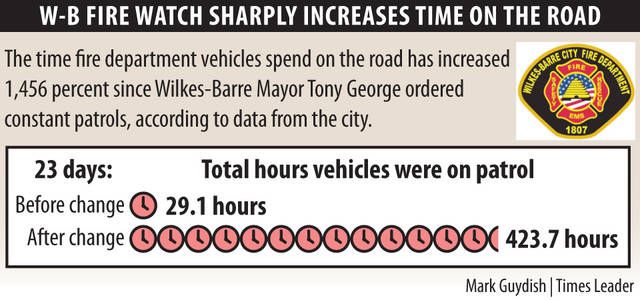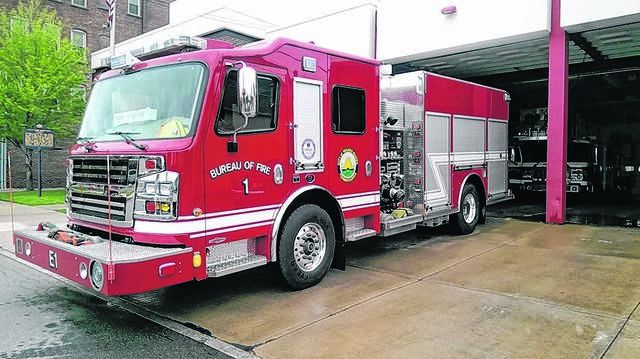Click here to subscribe today or Login.
WILKES-BARRE — After its patrol as part of the stepped-up Community Fire Watch during the predawn hours of Sept. 6, the crew from Engine 2 returned to Hollenback Station without having seen a flame or plume of smoke.
From 4 a.m. to 6 a.m., the engine and its firefighters rolled through half of the city, covering the North End and East End neighborhoods, Parsons and Miners Mills.
“Zones 2, 3 , 4 & 5 – Saw some rabbits. Nothing else to report,” read the entry in the Wilkes-Barre Fire Department’s daily log obtained through a Right to Know request.
The post was indicative of the attitude Local 104 of the International Association of Fire Fighters has toward the watch, leading them to question whether the program, ramped up by Mayor Tony George in August, made the city safer. George reinstated the watches, saying the firefighters weren’t carrying them out, but later corrected himself.
Union officials say the watches have been departmental practice, but the mayor’s mandate vastly increased how much time is spent on them. They and officials from other fire agencies contacted by the Times Leader question the value of the mayor’s program.
A review of the logs showed a 1,456 percent increase in the time spent on the watches. The comparison covered 23-day periods before and after the mayor’s mandate.
From the afternoon of Aug. 15 to Sept. 6, the last log date provided in the RTK request, the department completed 288 watches for a total of 423.7 hours. For the 23 days from July 24 through Aug. 15, the department completed 90 trips totaling 29.1 hours.
Outside views
Williamsport Fire Chief Todd Heckman doubted the effectiveness of the Wilkes-Barre watches. “I don’t know where it has its merit,” he said.
“We have used fire watches in the past only when there was arson hits,” Heckman said Friday. That was seven or eight years ago and Heckman said they put unmarked vehicles and personnel on the streets.
Heckman raised the same issues as Local 104 — specifically that fire apparatus is not meant for patrolling, the watches waste fuel and he didn’t consider it a best practice.
“It all adds up at the end of the day,” Heckman said.
Career firefighters are often characterized as “overpaid and underworked,” but are praised when they save lives and property, Heckman said.
A spokesman for the IAFF’s Washington, D.C., office said the Wilkes-Barre local, like all 314,000 IAFF members, is committed to the safety of the community.
“This program differs from most municipal public safety programs,” IAFF spokesman Timothy Burn said of what Wilkes-Barre is doing. “Though perhaps well-intended, it appears to do little to improve safety and may actually defer fire department resources that could be better utilized.”
Departmental practice
The watches have been a departmental practice as noted in its 2017 annual report and by Mike Bilski, president of Local 104.
“For years we have been training, performing community fire watches, doing pre-plans, and teaching fire safety classes during our shifts, but now we are mandated to patrol zones in the city in hopes to find something amiss,” Bilski said in a Sept. 1 post of the union’s Facebook page.
But the mayor’s mandate changed the neighborhood drive-throughs checking on abandoned or vacant properties to around-the-clock patrols and required detailed documentation for each run.
“The only time fire apparatus is to be in the fire stations is a shift change, while completing scheduled daily tasks, vehicle and equipment inspections and one hour prior to the end of each shift to complete reports. There will be a one-hour period for lunch and dinner. Apparatus may also return to the station to use the restroom, restock supplies and equipment, and to decontaminate/clean up,” stated the Aug. 23 department memo obtained by the Times Leader.
It was revised the following day to reduce the patrols to two-hour shifts between 8 p.m. and 6 a.m. “During these hours there will always be one apparatus on the road. All other details of the directive remain in effect,” said the Aug. 24 memo.
The mayor described it as a preventive measure, and the 911 center is informed of the apparatuses’ locations for dispatch purposes.
“That’s so they know where they’re at in case there’s a fire,” the mayor said.
The daily logs noted the conditions of hydrants and the routes covered throughout the various assigned coverage zones. There were no fires discovered on the watches. Instead, the log entries often included remarks such as “all okay,” or “nothing found” or “nothing unusual.”
The Easton Fire Department doesn’t drive its engines and trucks around the city streets on patrol, said firefighter Jorge Rivera, president of Local 713 of the IAFF. He wasn’t surprised the Wilkes-Barre watches came up empty.
“It doesn’t make sense,” Rivera said.






